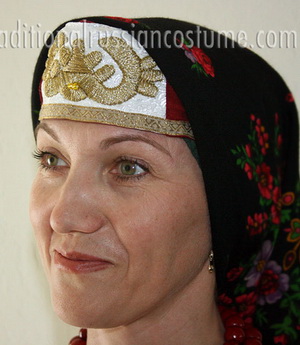|
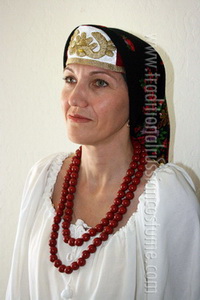 From 1550s till early 1800s a city of Kargopol have been an important trade center of the Northern Russia. That's why a traditional costume formed there was very rich-looking one,and consisted of many pieces. "Kargopol merchant's wife was required to have a golden-embroidered dress", as it was written in papers of that time. The most complicate designs and the most rich cloth and thread were used for headdresses. This part of a costume marked a wealth and social category of the wearer.<
From 1550s till early 1800s a city of Kargopol have been an important trade center of the Northern Russia. That's why a traditional costume formed there was very rich-looking one,and consisted of many pieces. "Kargopol merchant's wife was required to have a golden-embroidered dress", as it was written in papers of that time. The most complicate designs and the most rich cloth and thread were used for headdresses. This part of a costume marked a wealth and social category of the wearer.<
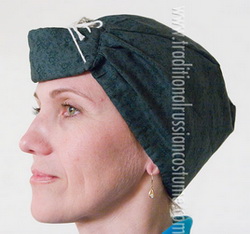 This headdress signs that its wearer is a married woman, who has at least one child. Married women who didn't give birth to a child yet wore a "kokoshnik", decorated with pearls and golden embroidery."Soroka" showed "next" level of family status. After all, soroka is more ancient piece of cloth than kokoshnik. And, speaking of regions, soroka had been worn almost everywhere in Russia, whereas kokoshnik was known in northern regions of Russia only.
This headdress signs that its wearer is a married woman, who has at least one child. Married women who didn't give birth to a child yet wore a "kokoshnik", decorated with pearls and golden embroidery."Soroka" showed "next" level of family status. After all, soroka is more ancient piece of cloth than kokoshnik. And, speaking of regions, soroka had been worn almost everywhere in Russia, whereas kokoshnik was known in northern regions of Russia only.
Kargopol-style soroka consists of three parts. A "sderikha"-hat has to be put on first. It, on the one hand, works as "povoynik" (a required headdress for married woman: its magical purpose was to hide woman's hair completely). On the other hand, a hard forehead part of a sderikha (a "hoof") makes a base for an embroidered design of a soroka. Sderikha suppose to be covered completely by next two pieces, so it usually was made of the cheapest fabrics.
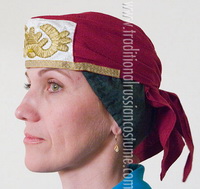 Soroka itself is a cotton shawl of an odd shape pretty similar to a flying bird's silhouette. Its forehead part is made of the most expensive fabrics (silk or velvet, usually red, crimson, blue, or white). The decoration there is generous : it is made of pearls or/and golden embroidery. Speaking of golden embroidery craft, scientists believe it started in Russia at 1700s. First it was used in monasteries, and later craftswomen (usually nuns) taught peasant girls from nearby villages.
Soroka itself is a cotton shawl of an odd shape pretty similar to a flying bird's silhouette. Its forehead part is made of the most expensive fabrics (silk or velvet, usually red, crimson, blue, or white). The decoration there is generous : it is made of pearls or/and golden embroidery. Speaking of golden embroidery craft, scientists believe it started in Russia at 1700s. First it was used in monasteries, and later craftswomen (usually nuns) taught peasant girls from nearby villages.
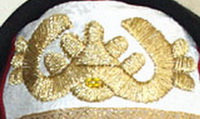 Craftswomen called a forehead design "a pretty frog". Actually it is a very stylized pictograph of a woman-in-labour. "A pretty frog" was a "must-be" ornamentatin for headdresses and shirts of married women.
More ancient "pretty frogs" were more lifelike (perhaps, too lifelike). Strictly speaking, "pretty frogs" were no less than graphic spell for fertility.
Craftswomen called a forehead design "a pretty frog". Actually it is a very stylized pictograph of a woman-in-labour. "A pretty frog" was a "must-be" ornamentatin for headdresses and shirts of married women.
More ancient "pretty frogs" were more lifelike (perhaps, too lifelike). Strictly speaking, "pretty frogs" were no less than graphic spell for fertility.
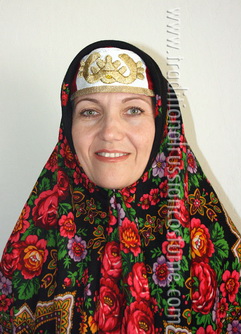
Soroka's golden forehead puts onto a "hoof", and soroka ties tightly behind a head. It almost hides a sderikha-hat.
Traditionally women put a colorful shawl over soroka, so only embroidered part above eyebrows remained visible.
Sources (in Russian)
- Kargopol State Ethnography Museum.
- "Wonderful Moments", a magazine (#2, 2003)
- G.S.Maslova, "Designs of Traditional Russioan Embroidery"
- Masterpieces of A.Belyakova & T.Valkova, restorers.
- S.P.Korablev, "Ethnographical and Historical Essay of Kargopol", 1851 (re-printed in 1993).
|

